中国是世界茶树的发源地,中国茶不仅历史丰富悠久,而且品种繁多。茶叶经历药用、食用到饮用,经历了几千年的历史,到了明末清初,各大茶类工基本定型,形成今天的六大茶类。理论上,同样的叶子竟然可以加工成不同的茶叶,拥有不同的颜色、不同的形状、不同的香气和不同的滋味,这也太神奇了。因此,引来了一个问题,我们是如何分类茶叶的?通过颜色?还是氧化程度?别担心,我们今天来一起寻找到答案。
China is the source of tea, owns the richest tea history, produces the most diversified types of tea in the whole world. Tea was taken used as medicine, then food, and then beverage finally. The six types of tea were completed in the late Ming and early Qing Dynasties, it's amazing how could the same leaves been processed into different teas with different colors, different shapes, different aromas, and different tastes. Here comes another question, how do we classify tea? By colors or oxidization degree? Don't worry, let's figure them out today!
中国茶历史悠久,但中国的现代茶学教育却还年轻。它发起于二十世纪初,其中最重要的始创之一就是陈椽教授。他于1908年出生于福建省。他终身致力于茶教育和茶产业的发展。他的一生完成并出版了无数著名的茶学专著和文章,如《茶叶通史》、《茶叶加工》、《茶叶种植》、《茶叶检验》、《茶叶商品学》。然而,遗憾的是,《茶叶化学》一书出版于2002年,即1999年他过世3年后。
Chinese tea has a very long history,while modern Tea Science is quite young. It was started in the early 20 century, one of the leading founders was professor Chen Chuan(1908-1999). who was born in 1908 in Fujian province. He had spent his whole time on tea education and tea industry. During his whole life, he finished and published lots of important and famous books and articles, for example, All The Tea in China, Tea Processing, Tea Cultivation, Tea Laboratory Science, Economics of Tea. However, it’s a pity that the book of Tea Chemistry was published in 2002, 3 years later than he passed away in 1999.
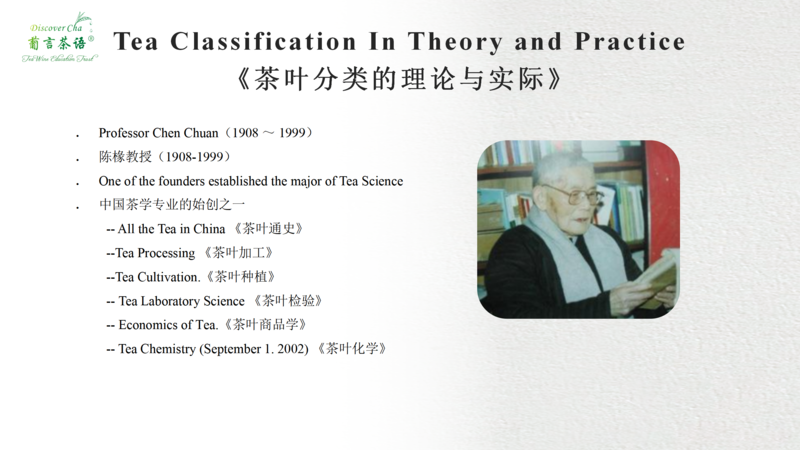
陈椽教授的另外一个成就就是《茶叶分类的理论与实践》。在那之前,茶叶分类系统一片混乱,混淆不清,他们简单地把茶根据”发酵“度发来,比如日本。直到1979年,经过多年的研究,他将茶叶分类成了六类:绿茶、红茶、黄茶、白茶、青茶(乌龙茶)和黑茶。这也是为什么现在仍然有人认为普洱茶是黑茶,正是因为这套分类理论。陈椽教授根据加工工艺和品质特点分类茶叶,换句话说,茶叶的品质特点取决于工艺。这套茶叶分类体系学术知识渊博且科学系统,因此被米歇尔,法国中国史学专家,翻译成英文,并很快发表在法国权威杂志(法国植物生物史专刊)上。
Professor Chen Chuan's other achievement is the Tea Classification in Theory and Practice. Before that, tea classification is a mess or confusing, they simply classified tea by “fermentation” degree, like in Japan. Until in 1979,after years of studying, he classified tea into six types of tea: green tea, black tea, yellow tea, white tea, oolong tea, and dark tea. That's why even now there are still someones think pu-erh tea belongs to dark tea because of this classification. Professor Chen Chuan classified tea based on the processing methods and characteristic qualities, which means that different processing results in different qualities. The tea classification was so knowledgeable and scientific that Michael Salt, the French Chinese history expert, translated it into English edition, and published it very soon in the famous French Journal(Journal d' Agriculture Traditionnelle et de Botanique Appliquee).
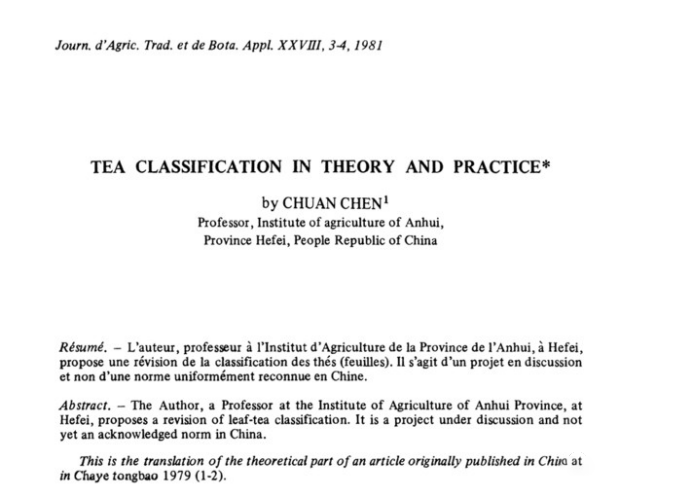
《茶叶分类的理论与实践》
然而,正如文中摘要所述,当时“这还是一个在中国需要进一步辩证的非确定的标准分类”。所以,接下来在80年代和90年代,在所有茶教育者的共同努力下,最终,茶被分成了三大类。第一大类为初加工(基础)茶类,它们是绿茶、白茶、黄茶、红茶、乌龙茶和黑茶;第二大类是再加工茶类,比如普洱茶、袋泡茶、香薰茶、抹茶等;第三类为深加工茶类,如速溶茶、茶饮料等。
However, just like the Abstract mentions, “it is a project under discussion and not yet an acknowledged norm in China" at that time. So later on in the 1980s and 1990s, with the efforts of all the tea educators, finally, tea is classified into three categories. The first one is the basic type of tea, they are green tea, white, yellow tea, black tea, oolong tea, and dark tea; The second category is reprocessed tea, like pu-erh, bag tea, scented tea, matcha and so on; The third one is further processed tea, like instant tea, tea beverage.

三者之间的区别是什么呢?基本茶类是经过一系列的连续工艺加工而成的,这可能需要十几个小时,两天,又或者数天,如黑茶。而再加工茶类的原料则是这六大基本茶类,但我们仍然可见全叶茶,或碎茶,甚至是茶粉和超微粉。深加工茶是现代产品,你看不见任何茶叶,但是能闻到并尝出茶叶的味道。
What are the differences between the three categories?Basic types of tea are been through a series of continuous processing steps, that take within one day, two days, or a few days, like dark tea. And reprocessed tea is processed from the basic types of tea, but you are still able to see either whole leaves, or broken leaves, even dust, fine powder, like matcha. Further processed tea is a modern tea product, you can not see any leaves but can smell and taste tea's flavor.值得注意到是,历史上普洱茶被误判为黑茶(点击了解更多),但普洱茶不是黑茶(点击了解更多)!
Please pay attention to that Pu-erh tea was initially classified into dark tea due to the piling fermentation and the lack of visibility in history(please click here to learn more), and Pu-erh tea(puer tea) is not any kind of dark tea due to the different species, areas, processings and features(click here to learn it more)!
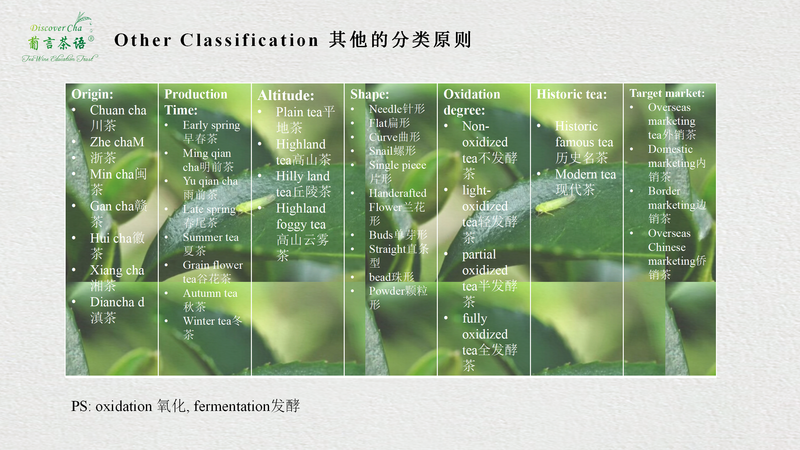
除了学术上的分类,还有一些其他的分类原则。比如原产地、生产时间、海拔、形状、氧化程度、历史地位,甚至是销售市场。这里要注意氧化和发酵两个术语,我们会在将来的课程中继续学习。
Besides the academic classification, there are other classification principles as well. Like by origins, production time, altitude, shape, oxidation degree, historic tea, even target market. Here,please pay attention to the term: oxidation and fermentation, we are going to learn about that in the near lesson, OK!
中国茶品种繁多,恐怕只有葡萄酒才能与之媲美了。葡萄酒的分类系统大致有原产地分级系统、酿造工艺和方法、残糖含量和采摘年份、以及葡萄品种等,且因为不同的国家或者地区而已,当然也会与时俱进,不断的完善。
Chinese tea is vast in diversified types, as many types as wine.The classification of wine can be done according to various methods including place of origin or appellation, vinification methods, and style, sweetness, and vintage, or variety used. Practices vary in different countries and origins, and many of them have varied over time although.
延生阅读 Read More
①按照最新的原产地分级系统可分为: 法国酒、地区酒以及法定产区酒(过渡期间旧的四级分级系统仍然沿用)。 需要注意的是,这个分级系统和波尔多1855年的酒庄分级是完全两个不同的系统。
①the new rules classify wine into three-level: Vin de France, IGP, AOP(meanwhile the old classification is still valid within some years). And it is significantly different from the Classification of 1855 in Bordeaux.

②根据酿造工艺,有红葡萄酒(很多国人用红酒代替了所有的葡萄酒)、白葡萄酒、桃红葡萄酒、起泡葡萄酒、甜酒、加强型葡萄酒。
②According to the vinification methods, there is red wine(most Chinese mistake red wine as all the types of wine), white wine, rose, sparkling wine, dessert wine and fortified wine.
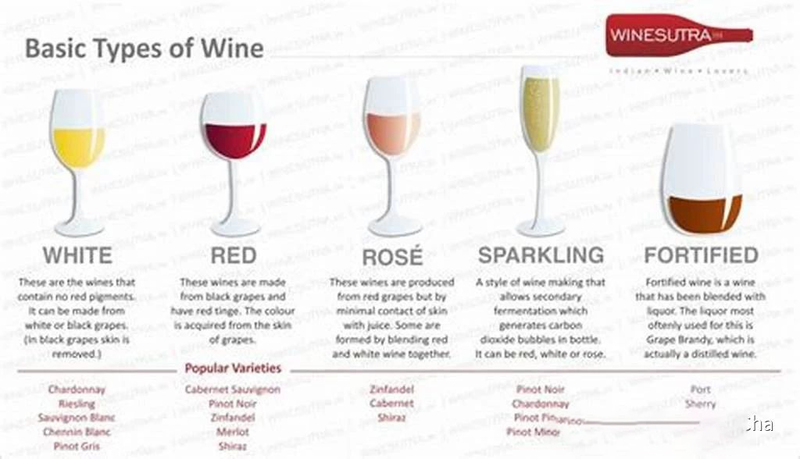
③根据酿造方法所得到的瓶内的压力还可以分为静止酒和起泡酒;
③According the pressure (injection of carbon dioxide), there is sparkling wine and still wine.
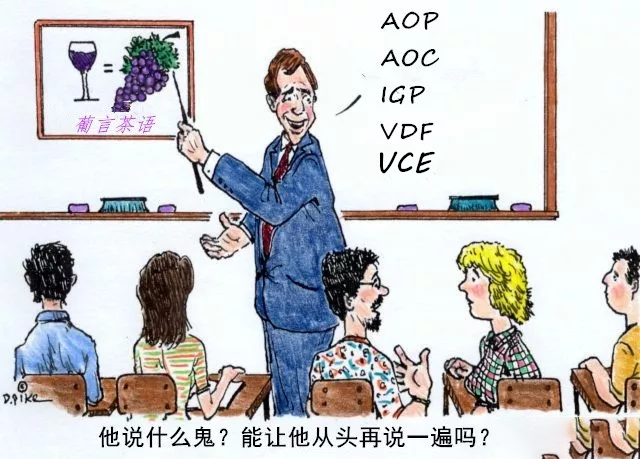
④根据残糖含量可以分为干型(< 4g/L)、半干型(< 4-12g/L)、半甜型(< 12-45g/L)和甜型(> 45g/L)(香槟略有不同,分为:自然干、超天然、天然、极干、干型、半干和甜型)。
④According to the sweetness, there is dry wine, semi-dry, semi-sweet, and sweet wine(champagne is classified as: Brut Nature, Extra Brut, Brut, Extra Dry, Dry, Demi-Sec and Doux ).
⑤年份对于葡萄酒是比较重要的,常有大年,小年之说。根据采摘年份分为年份酒和无年份酒。
⑤Vintage is considered to be important to wine as usual. A vintage wine is one made from grapes that were all, or primarily, grown in a single specified year, and are accordingly dated on the label.

⑥葡萄品种分类就更加纷繁复杂了,主要的葡萄品种有赤霞珠、梅洛、品丽珠、黑皮诺、马尔贝克、西拉、歌海娜、霞多丽、长相思、雷司令、琼瑶浆等等,常见的为混酿的葡萄酒,其中,只有某一种葡萄酒所占比例超过85%才能将其品种标注在酒标上,如霞多丽、赤霞珠等。
⑥Regarding the varieties, there are over 1000 grape varieties, and the main ones are cabernet sauvignon, merlot, cabernet franc, pinot noir, malbec, syrah, grenache, chardonnay, sauvignon blanc, chardonnay, Riesling, gewurztraminer. A varietal wine is a wine made from a dominant grape a minimum of 85% such as a Chardonnay or a Cabernet Sauvignon and labeled by the name of the grape variety, however, the blending wine is more common.
来源: 普洱杂志
如涉及侵权请联系删除












